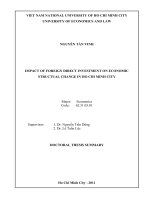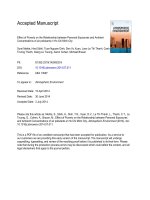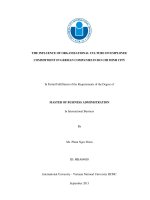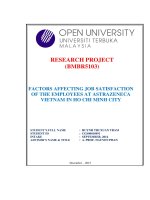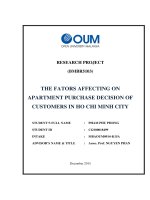The impact of marriage on happiness in ho chi minh city of vietnam
Bạn đang xem bản rút gọn của tài liệu. Xem và tải ngay bản đầy đủ của tài liệu tại đây (3.38 MB, 85 trang )
UNIVERSITY OF ECONOMICS
HO CHI MINH CITY
VIETNAM
ERASMUS UNVERSITY ROTTERDAM
INSTITUTE OF SOCIAL STUDIES
THE NETHERLANDS
VIETNAM – THE NETHERLANDS
PROGRAMME FOR M.A IN DEVELOPMENT ECONOMICS
THE IMPACT OF MARRIAGE ON HAPPINESS
IN HO CHI MINH CITY OF VIETNAM
BY
TRAN PHAM BAO NGUYEN
MASTER OF ARTS IN DEVELOPMENT ECONOMICS
HO CHI MINH CITY, DECEMBER 2017
UNIVERSITY OF ECONOMICS
HO CHI MINH CITY
VIETNAM
INSTITUTE OF SOCIAL STUDIES
THE HAGUE
THE NETHERLANDS
VIETNAM - NETHERLANDS
PROGRAMME FOR M.A IN DEVELOPMENT ECONOMICS
THE IMPACT OF MARRIAGE ON HAPPINESS
IN HO CHI MINH CITY OF VIETNAM
A thesis submitted in partial fulfilment of the requirements for the degree of
MASTER OF ARTS IN DEVELOPMENT ECONOMICS
By
TRAN PHAM BAO NGUYEN
Academic Supervisor:
Dr. TRUONG DANG THUY
HO CHI MINH CITY, DECEMBER 2017
ABBREVIATIONS
GSO
General Statistics Office of Vietnam
SMAM
The singulate mean age at the first marriage
HCMC
Ho Chi Minh City
SWB
Subjective well-being
WVS
World Value Survey
CIV
Core independent variables
CV
Control variables
OLS
Ordinary Least Squares
NORC
National Opinion Research Center
VNP
Vietnam – The Netherlands Programme
ABSTRACT
The main purpose of this research need to find the answer of the question if the
married woman will be happier than single folks over lifetimes as well the method of
measuring happiness in practice and the impact of marriage on happiness.
We desire to face a great challenge for the unsolved big problem and the results
will be motivated in most decisions related to marriage, all the beliefs, opportunities,
assumptions, perceptions and fears in mind happen. And could hope our valuable results
make many young males and females have re-considered their beliefs on marriage to lead
lasting happiness and their roles and responsibilities in shaping the future society.
TABLE OF CONTENTS
ABBREVIATIONS ........................................................................................................................................ iii
ABSTRACT.................................................................................................................................................. iv
LIST OF TABLES ........................................................................................................................................ viii
CHAPTER 1: INTRODUCTION ..................................................................................................................... 1
1.1.
Objective and motivation ........................................................................................................ 1
1.1.1
Research objective .............................................................................................................. 1
1.1.2
Research question ............................................................................................................... 3
1.1.3
Motivation ........................................................................................................................... 3
1.2.
Organization of the thesis........................................................................................................ 3
CHAPTER 2: LITERATURE REVIEW ............................................................................................................. 6
2.1.
Happiness ................................................................................................................................ 6
2.1.1
The science of happiness .................................................................................................... 7
2.1.2.
Empirical studies of happiness ............................................................................................ 9
2.2.
Marriage ................................................................................................................................ 15
2.2.1
Empirical studies of marital and happiness ...................................................................... 17
2.2.2
Method.............................................................................................................................. 22
CHAPTER 3: RESEARCH METHODOLOGY ................................................................................................ 26
3.1.
Determine sample size: ......................................................................................................... 26
We need 384 samples but finally we get 397 which are fine to continue. ......................................... 26
3.2.
Data collection ....................................................................................................................... 26
3.3.
Econometric models .............................................................................................................. 28
Conceptual framework ............................................................................................................................ 29
CHAPTER 4: RESEARCH RESULTS ............................................................................................................. 31
4.1.
The summary statistics .......................................................................................................... 31
4.1.1.
Independent variables ...................................................................................................... 31
4.1.1.1.
Variables of general information .................................................................................. 31
4.1.1.2.
Variables of married women ........................................................................................ 35
4.1.1.3.
Variables of husband .................................................................................................... 40
4.1.2.
4.2.
4.2.1.
Dependent variables ......................................................................................................... 44
Results.................................................................................................................................... 46
Basic model ....................................................................................................................... 47
4.2.2.
Full model .......................................................................................................................... 51
CHAPTER 5: CONCLUSION AND IMPLICATION ........................................................................................ 59
5.1.
Conclusion ............................................................................................................................. 59
5.2.
Implication ............................................................................................................................. 59
REFERENCE ............................................................................................................................................... 61
APPENDIX ................................................................................................................................................. 67
LIST OF TABLES
Table 1: Descriptive samples
Table 2.1: Descriptive statistics by independent variables - general
Table 2.2: Descriptive statistics by independent variables – who is married
Table 2.3: Descriptive statistics by independent variables – related to husband
Table 2.4: Descriptive statistics by continuous variables
Table 2.5: Descriptive statistics by dependent variables
Table 3: Estimation results of the basic model
Table 4: Estimation results of the full model
CHAPTER 1:
INTRODUCTION
1.1.
Objective and motivation
1.1.1 Research objective
Basing on General Statistics Office of Vietnam - GSO (2015) 1̣ found that the
divorced or separated rate in women which was higher than among man in observed
group. For details, the divorce rate among woman was approximated 2.2% but the
divorce rate of man was occupied by a half, 1.1%. About the proportion of separated rate
in the woman was 0.6%, while the man only was 0.4%.
Why the women tend to divorce or wish a separate life these days? The
percentage of skilled female workers is increasing year by year from 12.3% in 20072 and
the updated figure to 19.3% in 20153. Female unemployment rate is approximately 2.26%
in 2015 4 . And monthly average income per capita is dramatically increased from
1,639,500 dong in 20055; 3,259,500 dong in 20106 and 5,695,300 dong in 20157.It can
explain why women tend to make their own financial decisions these days.
In addition, a glance at the past few years, the fact and the figure of marital status
indicated that the singulate mean age at the first marriage (SMAM) has been increased in
Vietnamese families, GSO (2015)8. SMAM in 1999 is 23.8 years and 2015 24.9 years, in
which, SMAM of males were higher than 1.2, 2.6, 3.4, 3.9, 4.1 years compared with
1
GSO (2015) – Major findings: The 1/4/2015 time-point population change and family planning
survey, table 2.1, page 34
2
GSO, 02.Popolation and Employment >> Percentage of trained employed workers by sex and by
residence 2007 female
3
GSO, 02.Popolation and Employment >> Percentage of trained employed workers by sex and by
residence 2015 female
4
GSO, 02.Popolation and Employment >>Unemployment and unemployment rate of labour force
at working age in 2015 by region and by sex
5
GSO, 02.Popolation and Employment >>Average income of employed workers in State sector by
kind of economic activity >>2005
6
GSO, 02.Popolation and Employment >>Average income of employed workers in State sector by
kind of economic activity >>2010
7
GSO, 02.Popolation and Employment >>Average income of employed workers in State sector by
kind of economic activity >>2015
8
GSO (2015) – Major findings: The 1/4/2015 time-point population change and family planning
survey, table 2.3, page 37
1
females in 1989, 1999, 2009, 2014 and 2015, respectively. The men tend to delay their
marriage and getting married at later ages. Their SMAM were 24.4 years in 1989 and 26.9
year in 2015.
For financially independent, then the open lifestyle of Vietnam women is moving
to get individual person’s value, life satisfaction than the past. They explore and define
themselves how they want as norms challenge. They are encouraged in active
participation and habit changes of a range of elements which considered uncommon or
stigmas in the past, for example together with friends or colleagues at beer clubs, pub,
bar, or travelling alone, even tattoo, etc.
In addition, they meet up friends frequently over growing with urgent haste of
social networking. The woman can make appointments or dating easily by signing in or
logging with any email or any phone number, approximately less than a minute into
Facebook, Twister, Skype, Instagram and many other things. The women love life
themselves with positive energy and thinking, so they make people around be happier by
offering empathy and support to others. They are willing to share deeper emotions such
as challenges and pressures in their life.
Deriving from Reuters titled “Vietnam experience a “quite” sexual revolution” by
McCool (2007) reported that an open sexual revolution is revealing in Vietnam, especially
keen for single women and Saigon is a typically example. Due to open-minded, the
couple recognized the same conceptual and moves and lives together immediately or
having pre-marital sex, then previous generations. Online social networking created
woman raise love and sex and sexual orientation directly without any shy.
The other sides, but if, some women are considering to be satisfied their own life
or/and the top of satisfaction is getting marriage? Or they are on pursuit of happiness and
seem to be the biggest challenges in their life? Or they do not know what is perfect
happiness called, just try to look for experience physical and emotional pleasure and find
out the best way to avoid pain?
When asking people around, I myself recognized that the women would be the
happiest when they are side by side and fit with their right man as well the way to lead a
loving marriage and drive a lasting happiness. Marital happiness has become the great
2
achivement much more than professional accomplishment in personal life of each
person. While the data above implied that the man have tended to decline his marriage
and the divoice rate in woman are dramatically increasing in the recent years. So, is
marriage considered significant accomplishment as many people put the most value on
and their faith on lasting happiness has not been unfounded?
We desire to face a great challenge for the unsolved big problem and the results
will be motivated in most decisions related to marriage, all the beliefs, opportunities,
assumptions, perceptions and fears in mind happen. And could hope our valuable results
make many young males and females have re-considered their beliefs on marriage to lead
lasting happiness and their roles and responsibilities in shaping the future society.
1.1.2 Research question
The main purpose of this research need to find the answer of the question if the
married woman will be happier than single folks over lifetimes as well the method of
measuring happiness in practice and the impact of marriage on happiness in Ho Chi Minh
City of Vietnam.
1.1.3 Motivation
We conduct at least 500 surveys of women at aged 18-65 who is living in Ho Chi
Minh City (HCMC) to find out the research question by using regression techniques. Our
results contribute ongoing discussions which related to the role of marriage on happiness
with comprehensive and critical insights. Besides, if this thesis might record great
achievements, we continue to explore to all woman in Vietnam. And results have
achieved to bring solutions for policy makers.
1.2.
Organization of the thesis
Our thesis includes five parts. The first part, we introduce research objective and
motivation, focused on the research question “if the married woman will be happier than
single folks over lifetimes?” Secondly, we research the theory and empirical studies which
measure happiness and happiness on marriage and their impact correlation with them.
Thirdly, we summarize statistics and results. The next, we state outstanding findings as
3
going to the finally conclusion and implication.
4
5
CHAPTER 2:
LITERATURE REVIEW
2.1.
Happiness
The question was raised how to measure individual happiness which will be taken
up and a sketch of the relationship between the affirmation of individuality and
happiness.
The book was named “Freedom and the Pursuit of Happiness” by Bavetta et al.
(2014) which demonstrated the theoretical foundations of happiness in economics. The
authors stated that happiness is measured through individual utility with two different
interpretations including experience utilities and decision utilities. Sometimes, the ideas
of “subjective well-being” and “happiness” have been used interchangeably.
Individual utility is defined by essentially subjective and free flow of pleasure and
pain. Experience utilities related to or considered in term of pleasant or unpleasant and
marvelous sensations to well-being. Decision utilities are satisfaction as well as making
decisions of consumption choices without hesitation. The relationship between utilities
1
and well-being in economics had been proposed as below: Ut =∫𝑡=0 𝑢(𝑐𝑡)𝑑𝑡, which in u
utility, c the consumption and U the total utility, t presents time. This function implies
that total utility is the sum of utility experienced from consumption over time.
Besides, the researchers revealed the different between the concept of life
satisfaction and happiness. Life satisfaction is influenced by socioeconomic status, while
happiness is more related to apart from contingent sequence.
Obtaining the valuable results, the authors have processed with a huge sample in
different situations from over time and cross sections and countries in the last thirty
years. They open to debate on some contentious issues about the reliability and validity
of the data when applied in the empirical modules. The experience utility has been
measured to base on individual well-being data of self-reported valuations. The data
source from World Value Survey (WVS) (2009) was used for analytics.
What the matter is how to construct a variable which seize both aspects of well-
6
being of life, thus, the economist created a variable which recommended measure of
subjective well-being (SWB). This combines from respondent’s interview or submission of
a survey about happiness and life satisfaction and divided by weighted of each variable.
The most popular approach the people are whether or not happy, the economists
frequently have asked directly such as “All things considered, how happy they are with
their life as a whole these days?”, using four level of measurement and coded from low
=1 to high = 4, corresponding with very happy, rather happy, not very happy, and not at
all happy, respectively. This scale demonstrated how happy the people enjoy.
On the other hand, whereas, life satisfaction is measured by the question
“Thinking of your life as a whole, would you consider how satisfied they are” with the
range from 1 with “not at all satisfied” to 10 with very satisfied.
The people evaluate the level of happiness and life satisfaction which basing on
their experience in term of from low level to high level. A high range of satisfaction, they
maximize benefits and get high quality of life. But the scale of happiness measurement is
aversion; the higher level is associated with lower levels of happiness. The relationship of
happiness, subjective well-being and life satisfaction are significantly correlated.
2.1.1 The science of happiness
According to Bronson and Merryman (2009), they have investigated that
Psychologists and neuroscientists indicated the area of the human brain responsible for
positive memories, feelings, motions and happiness which named the hippocampus. Its
important role related to form new experience events as well as training, feeding,
nurturing and improving mood and happiness.
Serotonin is a neurotransmitter which synthesized from the amino acid
tryptophan. It helps regulate learning, mood, impulsivity, sleep, sexuality and
appetite. Dopamine is a neurotransmitter which helps regulate the brain’s reward and
pleasure centers, movements and emotional responses. It is synthesized from tyrosine
that found in poultry, fish, milk, bananas.
Achor and Shawn (2011) stated that people should go outside at least 20 minutes
a day in good weather to boost positive mood, broadens thinking and improves working
7
memory. Exercise releases proteins and endorphins that make the brain feel happier.
Besides, they gave an interesting fact about 10% married people are happier then
unmarried people.
The happiest occupations focused on Clergyman, Actor, Architect, and Firefighter.
The most satisfied people were in Mexico and Puerto Rico and the most optimistic people
were in Nigeria and Mexico. In the whole world, the happiest people live in Iceland (94%),
Denmark (91%), Netherlands (91%), Sweden (91%), Australia (90%) and America is the
16th happiest country in the world. Happiness is maximized at 13.9oC/57oF. The happiest
kids in the world are Mexico, Spain, Brazil, Germany, America because they are close
friends and family.
Healthy people are happier 20% than average but having a child reduces
happiness by 0.24% on average. The two biggest factors that contribute to happiest
around the world are a sense of community and frequent community celebrations in
which 31% who attend a service monthly, 43% who attend church service weekly, 26%
who never attend church.
Eventually, Grimm et al. (2007) mentioned the amount of time should actively be
helping the people in community 2 hours a week, approximately 100 hours a year.
Additionally, Maslow’s Hierarchy of Needs, the ingredients for happiness are the most
important Life Purpose, Respect, Relationship and the last Basic Biological Needs. Income
above $20,000 per capita yields a minimal increase in happiness and people in the highest
income bracket are about 3.5% happier than average.
In a study of patients with depression of ABC News with “Study: Exercise Treats
Elderly Depression, only 9% of patients treat with exercise, 38% of patients’ treats with
medication, and 31% of patients’ treats with medication and exercise. And sleep-deprived
people have a harder time remembering positive ideas, and an easier time remembering
negative ideas.
Bronson and Merryman (2009) explained sleep-deprived people have a harder
time remembering positive ideas, and an easier time remembering negative ideas.
Especially, in a study of sleep-deprived college students, they remembered 81% of
negative words and only 31% of positive words.
8
Also following Steve Herman et al. (2007) indicated the happiest kids in the world
at Mexico, next Spain, Brazil, Germany and the fifth America. They supposed that the
most important source of a kids’ happiness is close friends and family.
2.1.2. Empirical studies of happiness
2.1.2.1.
Method of measuring happiness
Taking about happiness, this is an open question and it is hard to explain and
compare who is happier than another because there is no good definition which depends
on different situations as well as who are using the word for, for example, with the same
story, someone said that what an unfortunate, and others reckon that makes them be
happier. To measure happiness as well as to answer the question what happiness it is,
almost authors are using scale ladder as the main measurement of happiness.
Graham and Chattopadhyay (2012) defined happiness of respondent’s life now
and five years later compared to the happiest period on a 0-10 scale, 0 being the worst
and 10 being the happiest.
Additionally, Mencarini and Sironi (2010) indicated the relationship between
happiness, housework and gender inequality in Europe. The dependent variable used to
measure happiness though the question if “Taking all things together, how happy would
say you are?”. The answer was suggested on an ordinal scale ladder, ranging from 0 being
extremely unhappy and 10 being extremely happy. Follow the surveys, almost of
respondents tend to answer positively and saying they are happy in which more than half
of the target people chosen values of 7 or higher, and reaching a skewed direction of
happiness.
Lee and Ono (2012), Baranowska-Rataj et al. (2014), Vanassche et al. (2013),
Dursun and Cesur (2016) and following the source of World Value Survey surveyed the
happiness though the question “How happy they are in their life generally” by a fourpoint ladder scale: “very happy – quite happy – somewhat happy – not at all happy” or
“completely happy―very happy―fairly happy―neither happy nor unhappy―fairly
unhappy―very unhappy―completely unhappy”, or or 5 points scale with 5 being “very
happy,” 4 happy,” 3 “neither happy, nor unhappy,” 2 “unhappy,” 1 “very unhappy. But,
9
Mencarini and Sironi (2010) used the answer on ranging from 0 for extremely unhappy to
10 for extremely happy.
Besides, Rutgers et al. (2014), Mencarini and Sironi (2010) and Stokes and
Recascino (2003) demonstrated the ways they felt in their life with the same question “All
things considered, how satisfied are you with your family life?’’ but there are different
scale
ladders
seven
satisfied―neither
levels
satisfied
for
completely
nor
satisfied―very
unsatisfied―fairly
satisfied―fairly
unsatisfied―very
unsatisfied―completely unsatisfied and another categories range are defined from 0
being not at all to 6 being very or 1 for very dissatisfied, 5 for very satisfied.
Another paper of Lee and Ono (2010) still found out the coordination between
specialization and the happiness in marriage between two developed countries U.S.–
Japan with the big data from the General Social Survey which operated and administered
in the U.S. and Japan.
Furdyna et al. (2008) investigated happiness of married and cohabiting individuals
“Taking all things together, how would describe your marriage. Would you say your
marriage is …” with the ranging from 1 to 4 being very happy - a little happier than
average - just about average - or not too happy or from 1 to 3 being not too happy - 3
being very happy or from 1 to 5 being extremely unhappy - extremely happy. After that,
the second question is “Love and affection you get from your spouse and the
“understanding you receive from your spouse” with 7-point ladder from 1 “unhappy” to 7
“very happy”. And the last question is “About how often did you and your wife spend
time alone with each other, talking, or sharing an activity” is based on the ranging from 1
“never” to 6 “almost every day.” (Lee and Ono, 2008; Schoen et al., 2002; Kaufman and
Taniguchi, 2006 and Wilcox and Nock 2006).
Mentioned about happiness in general, Ifcher and Zarghamee (2014) and Wolfers
(2009) suggested ‘‘Taken all together, how would you say things are these days - would
you say that you are …” with 3 point-scale ladder very happy - pretty happy/fairly - or not
too happy.
Or Lee and Ono (2012) and Treas et al. (2011), Carbonell and Paul Frijter (2004)
proposed ‘‘If you were to consider your life in general, how happy or unhappy would you
10
say you are, on the whole?”, scale ladder from 1 being completely unhappy to 7 being
completely happy or using the 10 point-scale from 1 being totally unhappy, and 10 being
totally happy.
Finally, reference the measurement of happiness of The Office for National
Statistics published “How happy are you right now” with respondents’ answer as follows
Content – Satisfied – Anxious. Basing on a 10-point scale of Integrated Household Survey
(IHS) propounded “How satisfied are you with your life nowadays?” or “How happy did
you feel yesterday?” or “How anxious did you feel yesterday?” or “To what extent do you
feel the things you do in your life are worthwhile?”. Next, the World Values Survey
challenged “How happy do you feel at the present moment” or “How well do you feel
your life is going,” with 3 level responses very happy - moderately unhappy – neutral.
2.1.2.2.
Factors affecting happiness
In analyzing the determinants of happiness, researchers found out many factors
which affected to that concept directly. Firstly, Rataj et al. (2014) investigated 5 groups of
factors such as child-partnership and age, education, satisfaction with health, satisfaction
with income, labor market situation of the mother and the partner on happiness.
Next, Graham and Chattopadhyay (2012) indicated 6 implements as independent
variables including age, sex, marital status, employment, geography, health. In which,
each factor was classified such as age and its square term, sex for male or female, and
marital status for single, married, separated, divorced, or widowed; employment basing
on household income; geography for urban or rural; health for satisfaction with
freedom.
Additionally, Rutgers et al. (2014) mentioned independent variables such as
marital quality, with control variables relate to age. The one more a research of Gash et
al. (2012) suggested hours of work of part-time job and control variables like age,
education, along with important life events like having a children or anniversary of
marriage, changes in health, and upgrading or downgrading job. The authors collected in
matrix X of a set of control variables. A dummy variable indicated whether the people
have switched to a part-time position and another switched to a full-time position.
And Ifcher and Zarghamee (2013) explored the happiness by controlling for single
11
mothers’ demographic characteristics including gender, age, race, native born, number of
children, marital status (single vs not single), educational attainment, health, family
income, and region. Lee and Ono (2010) found out the relation between specialization
and the happiness in marriage between U.S.–Japan comparisons. Data from the General
Social Survey administered in the U.S. and Japan. Variables include the following as
education coded as years of schooling completed, employment status of respondent and
employment status of spouse 0 being not working, 1 being working).
Lee and Ono (2012) demonstrated independent variables such as country, marital
status, societal gender beliefs (SGB). SGB indicated the relationship of gender beliefs in a
country and gender (female), and the living in a country with traditional expectations.
Regarding gender roles in the family and being a cohabiter, SGB indicated the gender
roles in the family and not being married or cohabiting, gender and parenthood status,
employment, and income, as well as marital status.
Liang et al. (2014) discussed 6 categories variables. The number one was personal
details such as occupation, age, and education attainment. The number two was
economic situation including living condition, and health care conditions. The number
three was social relations including relationship with in-laws, children, husband and
neighbors. The number four was local government including government policies,
government efficiency.
The number five was physical and psychological status including condition of
work, health status, optimistic personality, and loneliness. The number six was financial
burdens with the amount of dependent children and elderly people. Among categories 2,
3, 4, 5, the authors showed 13 questions to be answered using scale ladder, whereas a 1
being ‘‘strongly disagree’’, a 2 being ‘‘Disagree’’, a 3 being ‘‘Neutral’’, a 4 being ‘‘Agree’’
and a 5 being ‘‘strongly agreed’’.
For education attainment, a 1 was assigned with ‘‘primary school and below’’, 2
for ‘‘junior middle school’’, 3 for ‘‘high school (vocational school)’’, 4 for ‘‘junior college’’
and 5 for ‘‘bachelor’s degree and above’’. For occupation, ‘‘farming’’ added with a 0 and a
1 with ‘‘non-farming’’, the maximum total score of 100. After surveying, if the scores
below and equal 39 is represented unhappy index, basic happiness from 40–59, range of
60–79 for happy and the last, 80–100 for very happy.
12
Mencarini and Sironi (2010) measured happiness by income or other monetary
such as consumption expenditure, women’s demographic and socioeconomic
characteristics. The authors also used the dummy variable if 1 indicating woman is
engaged and a share of household labor more than 75 percent.
Treas et al. (2011) described the relationship of happiness with family income and
home environment and work status onside. The authors indicated four dummy variables
such as full-time worker, part-time worker, home- maker, and others unemployment, for
example student, unemployed, disabled, others. And, control variables included age, agesquared, number of children and education, gender attitude liberalism and the frequency
of attendance at religious services.
Besides, there is the six-point scale ladder of educational qualifications ranges
from 0 for no formal qualifications to 5 for university degree completed. Dummy
variables of work status categories included homemakers, part-time workers, and others
unemployment but full-time workers were the omitted reference category. Variables of
family income, husband's household task-sharing, perceived fairness of the division of
housework, family stress and couple conflict over housework were the mediating
variables.
Furthermore, Swami et al (2015) also measured happiness basing on weight such
as body dissatisfaction, body appreciation, and subjective happiness, and demographic
data such as education, age, and body mass index.
Therewith, following the research of Vanassche et al, (2013), they introduced core
independent variables (CIV) including marital status, the number of young and older
children. Control variables (CV) included age, education, employment status. CIV at the
national level were the level of importance marriage, appreciation of parenthood,
disapproval of alternative family types. CV at the national level was Gross Domestic
Product Per Capita.
Stokes and Recascino (2003) showed the affected factors to happiness, the
authors introduced some scale ladders. The first ones, Body Esteem Scale indicated the
level of satisfaction on a 5-point range 1 for very dissatisfied, and 5 for very satisfied. And
the second ones, Eating Attitudes Test was a 6-point scale ladder including 1 being never,
13
2 being rarely, 3 being sometimes, 4 being often, 5 being very often, 6 being always.
The third ones, Life Satisfaction presented a 5-point response scale 1 for strongly
disagree, and 5 for strongly agree. And the last ones, Demographics of participants asked
to check rate at level of religiosity/spirituality on a 9-point scale ladder such as 1 for not
at all, 9 for very.
2.1.2.3.
Estimation
Leading to the good results, each author used different method each. Firstly, Rataj
et al. (2014) considered to solve the impacts of single motherhood on happiness by using
mixed-method approach. Semi-structured face-to-face interviews identified the positive
and the negative factors of lone motherhood, and to re-build women’s perceptions in the
first stage. The second stage, the authors estimated though ordered probit model, fixedeffects and random-effects model, using panel data including all single mothers, the
divorced and widowed.
Next, Gash et al. (2012) used an Ordinary Least Squares (OLS) and random effects
to measure the effect of a change in working hours on the changes in life satisfaction
focusing on non-employed women and when they enter the labour market as well as
using fixed effects to find out significant differences between women having full-time or
part-time jobs.
Additionally, Furdyna et al. (2008) investigated the relationship between wife-tohusband income ratio and marital happiness by OLS method. The research of John Ifcher,
Homa Zarghamee (2013) estimated using an ordered probit; robust standard errors.
The next, Lee and Ono (2010) were used ordered logits in all regressions and
separately for men and women, heteroscedasticity. The author estimated models
separately for men and women, controlling for age, age squared and survey year. The
survey year dummies are controlled by fixed effects.
And Lee and Ono (2012) recommended pooled OLS for all estimations. Therewith,
Mencarini and Sironi (2010) demonstrated a series of ordered probit regressions with a
multi-level structure. Treas et al. (2011) were used random effect models and OLS for all
regressions. Vanassche et al. (2013) estimated a linear mixed model and multilevel
14
ordered probit models and multinomial probit models. Stokes and Recascino (2003)
estimated a linear multiple regression for all methods. The the last ones, Wilcox and Nock
(2006) picked a series of ordinary least square (OLS) for all regression models.
2.2.
Marriage
Becker (1974) introduced marital benefits such as time, goods, and inputs in
household production which compared to single life. The author also indicated the
positive matching between men and women focused on IQ index, education,
attractiveness, height, race, skin color, religion, family origin, etc…The researcher
valuated the outputs of household and the division between wife and husband. One
again, the constitutor also analyzed the reason why lead the men and the women delay in
marriage, concept to trial marriage, or divorce.
The men and the women decided to get marriage if and only if they are increased
their utilities. Utilities was mentioned not only goods, services purchased, but also
commodities produced by each member in household. Commodities were listed such as
the quality of meals, conversations, quantity of children; respect each other, relaxation
and entertainment, love, sympathy, partner, and health.
To maximize utilities of each member in household, mean, they try to maximize
what they are received. Production function is Z = f(x1,…xm; t1...tk; E), where xi are the
different kinds of goods and services; tj are the time inputs of each members in household
and E is environmental variable. The economist examined the gain from marriage such as
balanced costs including legal fees and “love” fees; beneficial inputs including time and
market goods. Besides, it depends on beauty, education, intelligence and other
opportunities in market.
To distinguish married household and single household is of children. Everything
can purchase except own children. Generally, both the men and the women wish have
their own children and take care of them and love comes from physical and emotional
between each other. The children and all love are imperfect substitution because a single
side cannot produce them. The author’s explanation of marital benefits concentrates on
complementarity as main resources which gain from marriage between the men and the
women. It is expressed by Cobb-Douglas form. Simultaneously, he re-affirmed the
15
marriage involving one woman and one man is the most efficient form because of having
their own children and utilities.
Absolutely, love and caring will increase in the optimal sorting the real person who
want to share whole their life with and going to the end with marriage because love
raises community outputs and caring raised total income.
Besides, some factors related to choose the right partner including race, religion,
age, family background, education, annual income, and characteristic features such as
height, weight, skin color, passiveness and aggressiveness, etc. But the most important
thing, people tried to find the way to maximize utility, and focusing on household
commodity inputs and outputs.
Searching the appropriate “candidate”, the right person has the valuable
expectation no greater the cost of time and other inputs called “love cost” and related to
education, intelligence, income, family background, lifestyle, ambition, release stress and
pressure, strategy of partner’s life. The duration of searching depends on definition of
expected value and marriage comes when the people are lucky in their search. Secondly,
the data is collected and analyzed to predict their partner; the right person will appear
when the perfect information has. Then, they make decisions stay in the marital home as
well as about marriage: should they divorce or separate or re-marry after that.
Most of countries in the world, especially, Vietnam considered marriage as a
must-fulfilled obligation of children to their parents and social in generally, instead, it was
symbolized by the real love of the couples, the voluntary in nature and a strong feeling of
wanting together. In such an identification and prejudice, marital quality and stability had
been seriously related to marital satisfaction and conversely.
Goals for marriages affected daily activities which mentioned behaviors and wellbeing. But after reviewing human goals and classification them in details, among that
important goals referring to social relationships were judged at the most. Follow the
theory of marital satisfaction, the researchers’ defined “marital satisfaction” that mean
the aspects of people global subjective of their marital quality.
Relating to above statement, the economists try to focus on quality of marriage
but not their stability. Basing on observing, statistics data analysis, and the authors
16


